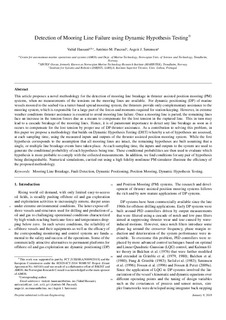| dc.contributor.author | Hassani, Vahid | |
| dc.contributor.author | Pascoal, António M. | |
| dc.contributor.author | Sørensen, Asgeir Johan | |
| dc.date.accessioned | 2019-03-11T10:15:19Z | |
| dc.date.available | 2019-03-11T10:15:19Z | |
| dc.date.created | 2018-05-18T13:28:20Z | |
| dc.date.issued | 2018 | |
| dc.identifier.citation | Ocean Engineering. 2018, 159 496-503. | nb_NO |
| dc.identifier.issn | 0029-8018 | |
| dc.identifier.uri | http://hdl.handle.net/11250/2589541 | |
| dc.description.abstract | Abstract This article proposes a novel methodology for the detection of mooring line breakage in thruster assisted position mooring (PM) systems, when no measurements of the tensions on the mooring lines are available. For dynamic positioning (DP) of marine vessels moored to the seabed via a turret-based spread mooring system, thrusters provide only complementary assistance to the mooring system, which is responsible for generating a large part of the forces and moments required for station keeping. However, in extreme weather conditions thruster assistance is essential to avoid mooring line failure. Once a mooring line is parted, the remaining lines must withstand an increase in the tension forces required to compensate for the lost tension in the ruptured line. This in turn may lead to a cascade breakage of the mooring lines. Hence, it is of paramount importance to detect any line breakage as soon as it occurs to compensate for the lost tension by proper use of DP thruster assistance. As a contribution to solving this problem, in this paper we propose a methodology that builds on Dynamic Hypothesis Testing (DHT) whereby a set of hypotheses are assessed, at each sampling time, using the measured inputs and outputs of the thruster assisted position mooring system. While the first hypothesis corresponds to the assumption that all mooring lines are intact, the remaining hypotheses are built assuming that a single, or multiple line breakage events have taken place. At each sampling time, the inputs and outputs to the system are used to generate the conditional probability of each hypothesis being true. The conditional probabilities are then used to evaluate which hypothesis is more probable to be compatible with the collected measurements. In addition, we find conditions for any pair of hypothesis to be distinguishable. Numerical simulations, carried out using a high fidelity nonlinear PM simulator, illustrate the efficiency of the proposed methodology. | nb_NO |
| dc.description.abstract | Detection of mooring line failures using Dynamic Hypothesis Testing | nb_NO |
| dc.language.iso | eng | nb_NO |
| dc.publisher | Elsevier | nb_NO |
| dc.rights | Attribution-NonCommercial-NoDerivatives 4.0 Internasjonal | * |
| dc.rights.uri | http://creativecommons.org/licenses/by-nc-nd/4.0/deed.no | * |
| dc.title | Detection of mooring line failures using Dynamic Hypothesis Testing | nb_NO |
| dc.type | Journal article | nb_NO |
| dc.type | Peer reviewed | nb_NO |
| dc.description.version | acceptedVersion | nb_NO |
| dc.source.pagenumber | 496-503 | nb_NO |
| dc.source.volume | 159 | nb_NO |
| dc.source.journal | Ocean Engineering | nb_NO |
| dc.identifier.doi | 10.1016/j.oceaneng.2018.01.021 | |
| dc.identifier.cristin | 1585591 | |
| dc.relation.project | Norges forskningsråd: 223254 | nb_NO |
| dc.description.localcode | © 2018 Published by Elsevier Ltd. This is the authors’ accepted and refereed manuscript to the article. Locked until 23 March 2020 due to copyright restrictions. This manuscript version is made available under the CC-BY-NC-ND 4.0 license http://creativecommons.org/licenses/by-nc-nd/4.0/ | nb_NO |
| cristin.unitcode | 194,64,20,0 | |
| cristin.unitname | Institutt for marin teknikk | |
| cristin.ispublished | true | |
| cristin.fulltext | postprint | |
| cristin.qualitycode | 1 | |

